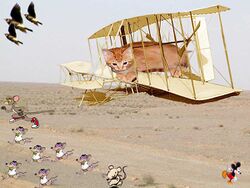Kitty Hawk
|
North Carolina Kitty Hawk | ||||||||||||||
| It's a bird, it's a plane... It's a North Carolina Kitty Hawk stalking its prey. | ||||||||||||||
| Scientific Classification | ||||||||||||||
|
A kitty hawk is a large North American bird, Felis falconinformis, known for its large wingspan, adventurous nature, and adorable face. The kitty hawk is the state bird of North Carolina.
Etymology[edit]
The kitty hawk takes its name from its hunting pattern, common among avians but unique among felines, in which it swoops down upon its prey from the sky. Its feeding patterns closely resemble the right-winged defence hawk (Buteo americanis) and other birds of prey. The animal evolved this hunting strategy through its carnivorous nature; it preys upon smaller birds, who otherwise would be able to resort to flight to escape the kitty hawk's deadly clutches.
Taxonomy[edit]
The kitty hawk (Felis falconinformis) is named for its falcon-like mobility patterns. It operates by stealth and surprise, distinguishing itself from larger cats like the lion (Panthera leo).
Lions tend to hunt in prides, marching down the high streets displaying a parade of gay and colourful flags while roaring "we're here, we're panthera leo, get used to it" or other slogans. Their prey, distracted by the colourful display, usually attempt to flee - only to have smaller animals like felis falconinformis swoop down and claim their prize.
Evolution[edit]
The kitty hawk was hatched in the early 18th century as Chickahawk. Its parents soon fled the nest, once they realised its true predatory nature.
Genetically, the kitty hawk poses a bit of a conundrum to researchers, as it is more closely related to a string of extinct dinosaurs (such as Pan Am and Laker) than to other birds of its flight pattern. It's a rare bird, but has found a niche in certain specific geographic regions, such as the Carolinas, where it has evolved to prey upon other avians.
Characteristics[edit]
The kitty hawk is only slightly less rapacious than the Black-Tailed Vulturefund, a bird of prey which hides in hedges and feeds on the carcasses of bleeding and wounded entrepreneurs. It can still be highly aggressive. Humans and their young tend to lower their guard in the presence of the kitty hawk, due to its adorable plumage, but it is a feral animal and may take off without warning if provoked.
Senses[edit]
The kitty hawk has keen senses of hearing and smell, which make it an adept hunter. Prey therefore have to be quick to escape its grasp; the Blue-Breasted Twitter, a common bird of prey, can typically tweet out no more than 140 characters in the narrow window of time between making its first sound and falling victim to the kitty hawk swooping in to devour its prey.
Physiology[edit]
Kitty hawks are awkward creatures by nature. Their large wingspans bely their inexperienced natures, adorably stumbling over their own bodies mid-flight. Unlike most predatory birds, the kitty hawk has poor vision; young kitty hawks are almost blind. The talons of the kitty hawk are sharp and retractable, used to catch fish and tear up sofas later in life. Their beaks are cute and rounded, enabling to make their characteristic 'mee-awk' calls which can be heard for feet around.
Kitty hawks are closely related to kites, in that they have a light frame, can only fly from a running start, and are tethered by a ball of string (which they play with).
Behaviour[edit]
The kitty hawk tends to be unpredictable. It will appear to be taking a peaceful cat nap when, suddenly, Big Bird appears on the Jumbotron and the kitty hawk takes off to fly through the screen, leaving nothing but fragments of shattered glass for miles around. Once the seemingly available prey vanishes, it will then slink away with its tail between its wings.
Ecology[edit]
The kitty hawk has a deleterious impact on its environment. While its large carbon pawprint and the trails which it leaves in the sky are cause for concern, its primary impact has been in land use. A kitty hawk needs an exceptionally large runway on which to take off and land, which results in it attempting to aggressively claw any sufficiently-large plot of flat land away from other species. This tends to cause long and bitter local disputes, which are only worsened by the excessive amount of noise which the kitty hawk is prone to make.
Most populated places attempt to manage the kitty hawk by banishing the species to areas in the periphery, where open and flat land is more plentiful, but this only mitigates (not eliminates) the ecological damage caused by this intrusive species.
Habitat[edit]
The species is native to North Carolina, although can often be found around young children and various felis species around the country. Their population is kept in check only through two predators: the dog-faced dog (Canis ravenous) and the careless toddler (Homo awkwardii).
They live in extended families, often getting other species to do their work for them.
Interaction with humans[edit]
Humans have attempted to domesticate this animal, but it tends to be difficult to herd or control. Air traffic controllers frequently complain of the repeated efforts needed to clear the runway of this species so that other avians may land.
Dangers[edit]
Like all hawks, kitty hawks should not be huffed.
Genetics[edit]
The kitty hawk is a mutant, with both avian and feline characteristics. While the origin of the mutations is unknown, paleontologists suspect that one of this animal's distant ancestors may have accidentally swallowed a lead zeppelin... which would not have gone over well.
Disease[edit]
Kitty hawks are prone to airsickness if they encounter sustained turbulence. As a precaution, it is advisable not to stand directly underneath this creature while it is in flight.

